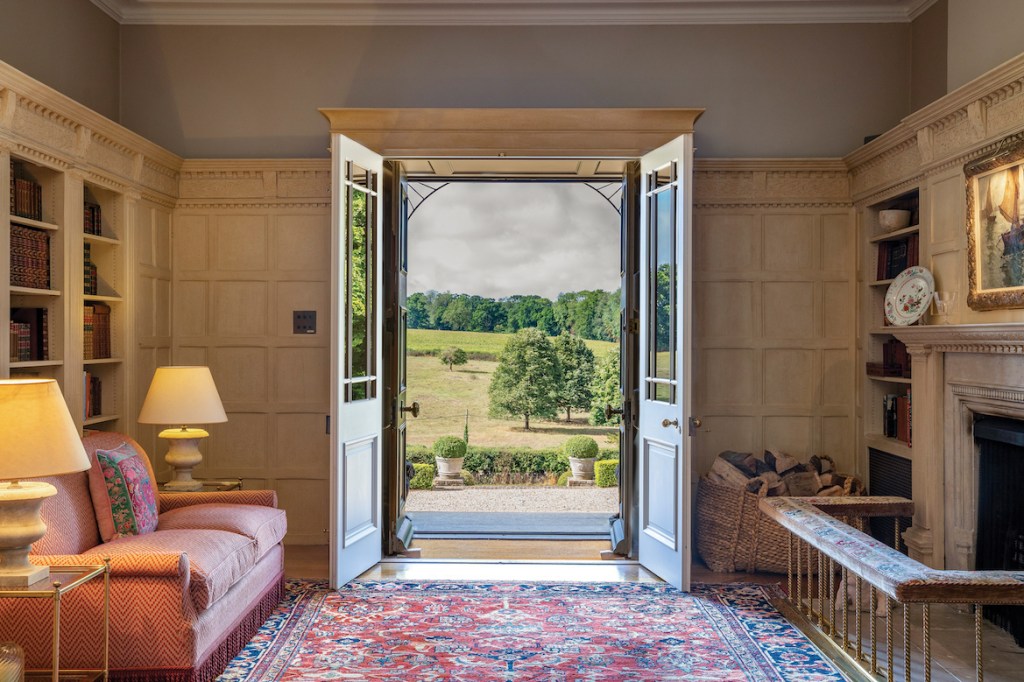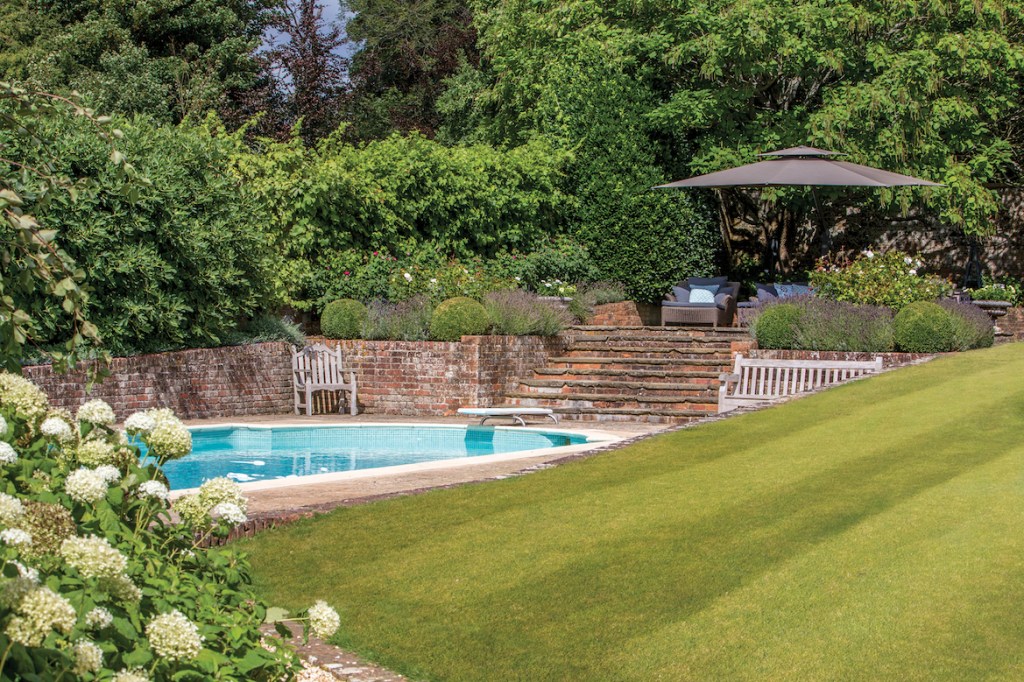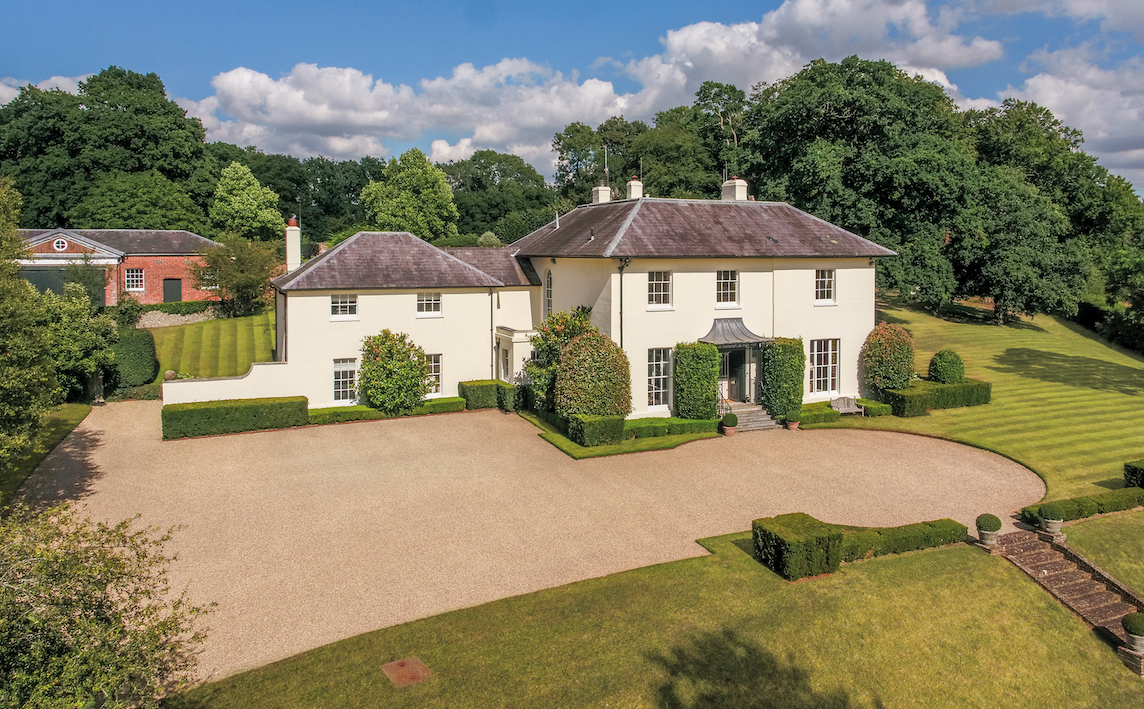‘There is nothing like staying at home for real comfort,’ wrote the eminently quotable Jane Austen in Emma, in 1815. ‘Nobody can be more devoted to home than I am.’
If the incomparable Regency writer and social critic could see Steventon House, on the site of her birthplace and childhood home in Hampshire, she would doubtless approve. Although it’s not quite on the scale of the manicured estates that feature so largely in her property-obsessed novels, the Grade II listed 1820s home is all Georgian elegance, with 7,000 sq ft of living space, beautifully proportioned high-ceilinged receptions and fine period features including decorative fireplaces, cornicing, and working shutters.
The six-bed property, in the village of Steventon, a 15-minute drive from Basingstoke, has been given a plush country-house makeover by the family that has owned it for the past eight years or so, now on the market for £8.5 million with Savills and Knight Frank. The news has set ‘Janeites’, as her hardened fans are known, aflutter, with American buyers soon expected to be jostling for viewings.
The home’s backstory is pure catnip for Austen aficionados. Steventon House is built on the plot on which her family home once stood, close to the village’s 12th-century Church of St Nicholas, at which Austen’s father was rector for more than 40 years. The writer, one of eight children, was born in the 16th-century home in 1775 and she spent the next 25 years of her life there. As a teenager, she filled her notebooks with irreverent, witty stories of family murders and heavy drinking, and would go on to draft three of her major novels, Pride and Prejudice, Northanger Abbey and Sense and Sensibility, under its roof.

Much to the horror of her devotees, however, after Austen’s father retired in 1801 and decamped the family to Bath, the house was pulled down by her older brother, Edward. He rebuilt it in its current incarnation, finally selling it in 1855 to the second Duke of Wellington.
There are clues, however, that the home contributed much to Austen’s early life, the place she dreamed up Elizabeth Bennet, Mr Darcy and the Dashwoods. Although thought to be an unreliable account of her true character, in A Memoir of Jane Austen, written by her nephew James Edward Austen-Leigh in 1869, the once remote rural house is described as ‘surrounded by sloping meadows, well sprinkled with elm trees, at the end of a small village of cottages, each well provided with a garden, scattered about prettily on either side of the road.’
Large enough to accommodate a growing family, as well as the boarding pupils the rector took in, ‘the rooms were finished with less elegance than would now be found in the most ordinary dwellings …. No cornice marked the junction of wall and ceiling,’ Austen-Leigh writes. ’There was a general deficiency of carpeting in sitting rooms, bedrooms, and passages. A pianoforte, or rather a spinet or harpsichord, was by no means a necessary appendage.’
A 2011 excavation of the field in which the house stood revealed its foundations, as well as fragments of blue willow-pattern plate, showing the Austens were following contemporary fashions in china, but certainly weren’t living a life of Regency glamour.
The present Steventon House remained a rectory until 1930. Today has all the hallmarks of a luxurious country home. The property comes with more than 50 acres – including a white wisteria walk, a lime tree said to have been planted by Austen’s father in 1813, an original water pump, plus a swimming pool and tennis court – as well as an oak-panelled drawing room, a vast kitchen-diner and two cellars.

In the grounds, there is also a two-bedroom, two reception-room cottage – perfect for parking an impecunious aunt – and a brick coach house with a workshop and double garage.
‘While the original house no longer stands, what is there today is the glorious Georgian vision of Jane’s older brother Edward, which is very befitting of the world that Jane wrote about,’ says Ed Sugden, director of Savills’ country house department.
You also get a sense of the bucolic bliss that the Austens enjoyed. The countryside around Steventon is all pretty lanes, meadows and hedgerows, though you can be at London Waterloo within an hour from Overton station, four miles away. The church is very much the same as it was in their day – possibly with fewer bonnets – and many of the Austen family are buried in the churchyard.
‘It’s a real cracker of a house,’ says Edward Cunningham, a partner and head of the southwest team at Knight Frank. ‘Although the global obsession with Jane Austen is expected to trigger interest from all quarters, the house is very private, set back at the end of a large drive. It’s not hard to imagine her scribbling away here. There are an awful lot of houses in Hampshire that claim connections to her, but this is the real deal.’
Available on Savills and Knight-Frank.






Comments